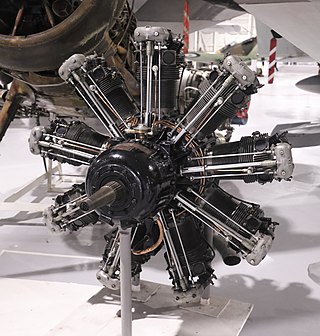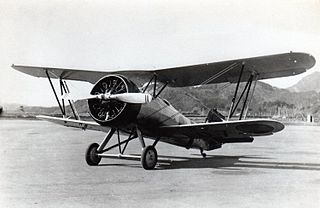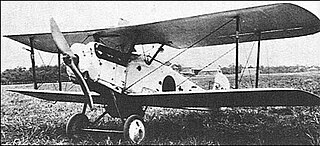
The Bristol Jupiter is a British nine-cylinder single-row piston radial engine that was built by the Bristol Aeroplane Company. Originally designed late in World War I and known as the Cosmos Jupiter, a lengthy series of upgrades and developments turned it into one of the finest engines of its era.

The Aichi B7A Ryusei was a large and powerful carrier-borne torpedo-dive bomber produced by Aichi Kokuki for the Imperial Japanese Navy Air Service during the Second World War. Built in only small numbers and deprived of the aircraft carriers it was intended to operate from, the type had little chance to distinguish itself in combat before the war ended in August 1945.

The Mitsubishi A5M, formal Japanese Navy designation Mitsubishi Navy Type 96 Carrier-based Fighter (九六式艦上戦闘機), experimental Navy designation Mitsubishi Navy Experimental 9-Shi Carrier Fighter, company designation Mitsubishi Ka-14, was a WWII-era Japanese carrier-based fighter aircraft. The Type number is from the last two digits of the Japanese imperial year 2596 (1936) when it entered service with the Imperial Navy.

The Nakajima Aircraft Company was a prominent Japanese aircraft manufacturer and aviation engine manufacturer throughout World War II. It continues as the car and aircraft manufacturer Subaru.

The Nakajima A4N was a carrier-based fighter used by the Imperial Japanese Navy, and the last biplane designed by Nakajima. The first prototype was completed in 1934, but, due to engine trouble, the aircraft did not see service until 1936. Given the Nakajima internal designation Nakajima YM, but the Japanese Navy designation was Navy Type 95 Carrier Fighter. A total of 221 were built. It saw combat in the Second Sino-Japanese War in the late 1930s.

The Gloster Gamecock was a biplane fighter designed and produced by the British aircraft manufacturer Gloster.

The Mitsubishi B1M was a Japanese torpedo bomber of the 1920s, also known as the Navy Type 13 Carrier-Borne Attack Aircraft. It was designed and built by Mitsubishi and used in combat against China. The aircraft was used by the air services of the Imperial Japanese Navy and Imperial Japanese Army.

The Yokosuka B4Y was a carrier-borne torpedo bomber used by the Imperial Japanese Navy Air Service from 1936 to 1943. The B4Y replaced the Mitsubishi B2M2 and the Yokosuka B3Y, and was the last biplane bomber used operationally by the Imperial Japanese Navy. The Allied reporting name was "Jean". This aircraft was mistakenly identified by the British as the Nakajima Navy G-96.

The Nakajima A2N or Navy Type 90 Carrier Fighter was a Japanese carrier-borne fighter of the 1930s. It was a single-engined biplane of mixed construction with a fixed tailwheel undercarriage.
The Nakajima Ha1 Kotobuki was an aero-engine developed by Nakajima. It was a radial piston developed under licence from the Bristol Jupiter.

The Nakajima Type 91 fighter was a Japanese fighter aircraft of the 1930s. It was a single-engine, single-seat parasol monoplane with a fixed, tailskid undercarriage.

The Mitsubishi 1MF was a Japanese carrier fighter aircraft of the 1920s. Designed for the Mitsubishi Aircraft Company by the British aircraft designer Herbert Smith, the 1MF, also known as the Navy Type 10 Carrier Fighter was operated by the Imperial Japanese Navy from 1923 to 1930.

The Mitsubishi Ki-2 was a light bomber built by Mitsubishi for the Imperial Japanese Army Air Service (IJAAS) in the 1930s. Its Allied nickname was "Louise". Despite its antiquated appearance, the Ki-2 was successfully used in Manchukuo and in North China during the early stages of the Second Sino-Japanese War in areas where danger from enemy fighter aircraft was minimal. It was later used in a training role.

The Mitsubishi K3M was a trainer built by Mitsubishi which was used by the Imperial Japanese Navy in an extremely wide variety of roles, including light transport, liaison aircraft, utility aircraft, and occasionally light bomber. Its Allied reporting name was Pine.

The Mitsubishi Ki-18 was an unsuccessful and unsolicited attempt by Mitsubishi to meet a 1934 requirement issued by the Japanese Army for a modern single-seat monoplane fighter suitable to the needs of the Imperial Japanese Army Air Force. During this competition, Nakajima entered the Nakajima Ki-11, and Kawasaki entered the more maneuverable Kawasaki Ki-10 biplane. The competition was won by Kawasaki, but the new fighter was not accepted by the IJAAF with much enthusiasm.

The Junkers K 47 was a two-seater fighter aircraft developed in Sweden by the Swedish subsidiary of the German firm Junkers during the late 1920s, a civil development of which was designated the A 48.
The Kawanishi K-11 was a 1920s Japanese single-seat carrier fighter designed and built by the Kawanishi Aircraft Company to meet an Imperial Japanese Navy requirement. The type did not enter service, and only two prototypes were built.

The Mitsubishi 1MF9 or Mitsubishi Experimental Taka-type Carrier Fighter was a prototype Japanese fighter aircraft of the 1920s. It was a single-engined, single-seat biplane intended to operate from the Imperial Japanese Navy's aircraft carriers, but only two were built, with the type being rejected by the Navy.
The Nakajima Ha5 is a twin row, 14 cylinder air-cooled radial aircraft engine built by the Japanese Nakajima Aircraft Company. The engine was a development of earlier single-row Japanese engines, the Kotobuki and Hikari, which had combined features of the Bristol Jupiter and Pratt & Whitney R-1340 Wasp designs.
The Mitsubishi Ka-8 or Mitsubishi Experimental 8-Shi Two-seat Fighter was a prototype Japanese two-seat carrier-based fighter aircraft of the 1930s. Two were built, but no production followed.

















